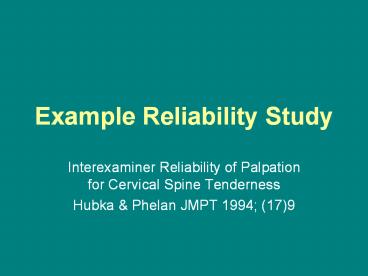Example Reliability Study - PowerPoint PPT Presentation
1 / 18
Title:
Example Reliability Study
Description:
Manual palpation is commonly used for examination of the musculoskeletal system ... to the findings of the first examiner, repeated the palpation examination ... – PowerPoint PPT presentation
Number of Views:19
Avg rating:3.0/5.0
Title: Example Reliability Study
1
Example Reliability Study
- Interexaminer Reliability of Palpation for
Cervical Spine Tenderness - Hubka Phelan JMPT 1994 (17)9
2
Background
- Manual palpation is commonly used for examination
of the musculoskeletal system - It is considered an important procedure for
deciding where to manipulate - Unfortunately, many diagnostic palpation methods
have not been found to be valid or reliable
3
Background Cont.
- Including motion palpation and static palpation
for vertebral misalignment - Palpation for tenderness has good to excellent
reliability for examination of the lumbar spine - It is frequently used to identify the source of
pain and target of spinal manipulation
4
Purpose
- To report the interexaminer reliability of
palpation for cervical spine tenderness in neck
pain patients
5
Methods
- Thirty patients with neck pain (the sample) were
recruited from a private chiropractic practice
(the population) - Inclusion criteria
- Experiencing unilateral neck pain diagnosed as
being mechanical
Pain aggravated by movement, relieved by rest
and not associated with serious underlying
pathology
6
Methods Cont.
- Exclusion criteria
- Patients with nonmechanical or undiagnosed neck
pain - Subjects were informed of the study and consented
to participate - Two chiropractors independently evaluated each of
the 30 patients
7
Methods Cont.
- Marks were placed on the skin overlying the C2
and C7 spinous processes - The examiners palpated with their second through
fourth fingertips, with their middle fingertip
directly over the skin mark - There was no attempt to standardize the amount of
pressure applied by each examiner
8
Methods Cont.
- The first examiner pressed over each skin mark
and asked the patient to indicate which spot was
the most tender - The second examiner, blinded to the findings of
the first examiner, repeated the palpation
examination - The order of the examiners was randomly varied
9
Statistical Analysis
- Interexaminer reliability was tested with a
within-subjects (repeated measures) design - Agreement between examiners on the most tender
spinal segment was calculated using kappa (K),
percent agreement, and standard error (SE)
10
Results
- Descriptive statistics
- 19 females and 11 males
- Average age (SD) of 39.4 (14.6) yr (range
21-78 yr). - Mean duration of pain (SD) was 21 (26.4) months
(range 2 days-2 yr) - Interexaminer reliability was found to be good (K
.68, p lt .001).
11
Results Cont.
12
Results Cont.
13
Limitations
- The possibility exists that error occurred while
locating and numbering the posterior joints
therefore, the reported frequency of
intervertebral joint tenderness may be inaccurate
- The examiners used different amounts of pressure.
However, they obtained a high level of agreement,
suggesting that palpation for tenderness is easy
to use
14
Conclusion
- Manual palpation for cervical spine tenderness is
highly reliable and simple to use in practice - It is also accurate for the diagnosis of cervical
spine posterior joint syndrome
15
Reliability/Validity Critical Appraisal Check
Sheet
- Were the methods of performance for the procedure
adequately described? Y _ - Was the proposed purpose or use of the test
described? Y _ - Were subjects with and without the disorder
included in the methods? _ N - Was the study population appropriate for
evaluating the proposed use of the test? Y _ - Were the inclusion and exclusion criteria
described? Y _ - Was an appropriate sample size considered? _ N
16
- Were demographic and clinical characteristics of
subjects described? Y _ - Was a normal/abnormal test value defined? Y _
- Was there enough detail to the data to calculate
appropriate results? Y _ - Was an appropriate gold standard used? _ _
- Were predictive values used correctly? _ _
- Was the test applied in manner replicating
clinical practice? Y _ - Do the benefits of this study outweigh the flaws?
Y _ - What are some additional questions that I should
ask before I use this diagnostic test/procedure?
- The authors indicated that the posterior
intervertebral joint was the problem. Could other
tissues be involved in a tender patient? - Does this mean that I should adjust this segment?
17
Figure 1
18
Figure 2































